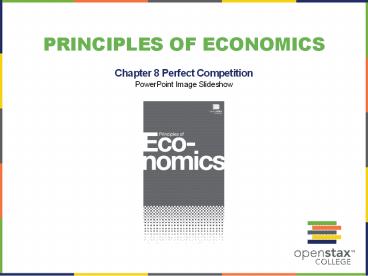Physics - PowerPoint PPT Presentation
1 / 9
Title:
Physics
Description:
PRINCIPLES OF ECONOMICS Chapter 8 Perfect Competition PowerPoint Image Slideshow FIGURE 8.1 Depending upon the competition and prices offered, a wheat farmer may ... – PowerPoint PPT presentation
Number of Views:34
Avg rating:3.0/5.0
Title: Physics
1
Principles of Economics Chapter 8 Perfect
Competition PowerPoint Image Slideshow
2
Figure 8.1
- Depending upon the competition and prices
offered, a wheat farmer may choose to grow a
different crop. (Credit modification of work by
Daniel X. O'Neil/Flickr Creative Commons)
3
Figure 8.2
- Total revenue for a perfectly competitive firm is
a straight line sloping up. The slope is equal to
the price of the good. Total cost also slopes up,
but with some curvature. At higher levels of
output, total cost begins to slope upward more
steeply because of diminishing marginal returns.
The maximum profit will occur at the quantity
where the gap of total revenue over total cost is
largest.
4
Figure 8.3
- For a perfectly competitive firm, the marginal
revenue (MR) curve is a horizontal straight line
because it is equal to the price of the good,
which is determined by the market, shown in
Figure 8.4. The marginal cost (MC) curve is
sometimes first downward-sloping, if there is a
region of increasing marginal returns at low
levels of output, but is eventually
upward-sloping at higher levels of output as
diminishing marginal returns kick in.
5
Figure 8.4
- The equilibrium price of raspberries is
determined through the interaction of market
supply and market demand at 4.00.
6
Figure 8.5
- In (a), price intersects marginal cost above the
average cost curve. Since price is greater than
average cost, the firm is making a profit. In
(b), price intersects marginal cost at the
minimum point of the average cost curve. Since
price is equal to average cost, the firm is
breaking even. In (c), price intersects marginal
cost below the average cost curve. Since price is
less than average cost, the firm is making a loss.
7
Figure 8.6
- In (a), the farm produces at a level of 50. It is
making losses of 56, but price is above average
variable cost, so it continues to operate. In
(b), total revenues are 72 and total cost is
144, for overall losses of 72. If the farm
shuts down, it must pay only its fixed costs of
62. Shutting down is preferable to selling at a
price of 1.80 per pack.
8
Figure 8.7
- The marginal cost curve can be divided into three
zones, based on where it is crossed by the
average cost and average variable cost curves.
The point where MC crosses AC is called the
zero-profit point. If the firm is operating at a
level of output where the market price is at a
level higher than the zero-profit point, then
price will be greater than average cost and the
firm is earning profits. If the price is exactly
at the zero-profit point, then the firm is making
zero profits. If price falls in the zone between
the shutdown point and the zero-profit point,
then the firm is making losses but will continue
to operate in the short run, since it is covering
its variable costs. However, if price falls below
the price at the shutdown point, then the firm
will shut down immediately, since it is not even
covering its variable costs.
9
Figure 8.8
- In (a), demand increased and supply met it.
Notice that the supply increase is equal to the
demand increase. The result is that the
equilibrium price stays the same as quantity sold
increases. In (b), notice that sellers were not
able to increase supply as much as demand. Some
inputs were scarce, or wages were rising. The
equilibrium price rises. In (c), sellers easily
increased supply in response to the demand
increase. Here, new technology or economies of
scale caused the large increase in supply,
resulting in declining equilibrium price.










![L 34 Modern Physics [1] PowerPoint PPT Presentation](https://s3.amazonaws.com/images.powershow.com/7125701.th0.jpg?_=20150905079)


![L 33 Modern Physics [1] PowerPoint PPT Presentation](https://s3.amazonaws.com/images.powershow.com/7602675.th0.jpg?_=201602121011)

















